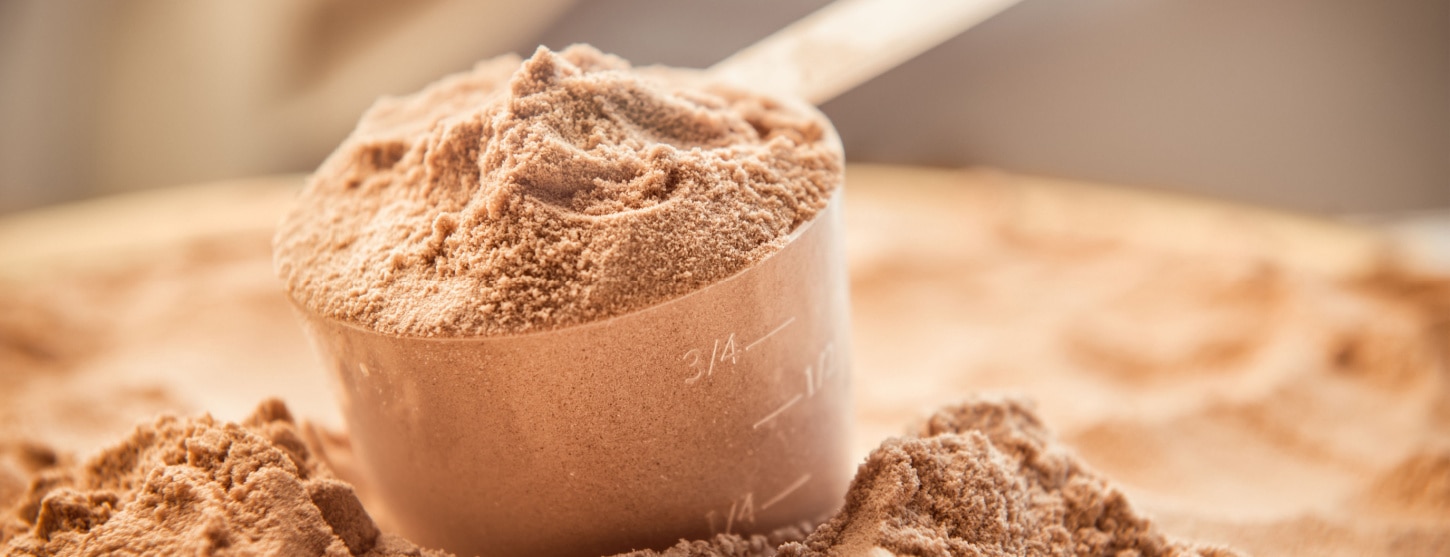15% off £25
Whey protein isolate vs concentrate & more

Whey protein is fast becoming one of the most popular protein supplements on the market, but understanding it can be tricky, especially with all the different names and terms out there.
You’ll probably spot different types of whey protein with names like ‘isolate’, ‘concentrate’ and ‘hydrolysate’.
But what do these terms mean? And how are they different to each other?
From isolate, concentrate, and hydrolysate to other forms like vegan whey protein, we’ll give you the low down on everything you need to know about the different types of whey protein.
Skip to:
What is whey protein?
There are two main types of protein found in milk: whey and casein.
Whey is a high-quality protein that is a by-product of the cheese or yoghurt-making process. It is considered a complete protein as it is packed full of essential amino acids that are absorbed quickly by our bodies.1
Whey is considered a complete protein, which means it contains all nine essential amino acids your body needs, including branched chain amino acids (BCAAs) like leucine.2 As a result, whey protein is a popular choice for athletes looking to build muscle and recover from intensive workouts.
When making dairy products, the liquid whey is separated from the curds during production. This liquid whey is mainly water, lactose, fat, minerals, and protein.
This liquid is sometimes then dried to create a fine powder - this is the whey protein powder we know and love.
Many studies have shown that some of the benefits of whey protein are building muscle and supporting weight loss, but protein is essential for everyone, no matter your goals, to keep your body functioning as it should.3
Your body needs protein for many functions, like creating hormones and keeping your bones strong, so it is important to maintain your protein intake.
The two most common forms of whey protein are whey protein concentrate and whey protein isolate, and whilst similar, each has a different refinement process that gives them unique properties.
There is even a third form of whey protein, whey protein hydrolysate, that has its own unique properties too.
So, if you're wondering what the difference is between all these types of whey protein, keep reading, as we'll explain below.
Whey protein isolate
Containing around 90% protein, whey protein isolate really packs a protein punch.
Whey protein isolate starts out as whey protein concentrate but goes through an extra filtration process that separates out fat, cholesterol, and lactose, creating a pure form of whey protein that is really lean.7
This process means that whey protein isolate has much lower fat, cholesterol, carbohydrate, lactose, and calorie content than other forms of protein on the market.
Whey protein isolate is thinner than concentrate and generally mixes easier, so it could be for you if you’re looking for a lean, pure protein to add to your protein shakes.
It is worth noting that whilst most of the lactose content has been filtered out, whey protein isolate will still contain a small amount of lactose. So, if you have a lactose intolerance or are dairy-free, it’s best to avoid it.8
Whey protein hydrolysate
Whey protein hydrolysate, also known as hydrolysed whey protein or hydrolysed whey protein isolate, is the purest form of whey protein made through an additional process called ‘hydrolysis’.
During hydrolysis, the protein chains are broken down by enzymes, creating smaller particles called peptides. Peptides are easily absorbed in the body, meaning whey protein hydrolysate has a much faster digestion and absorption rate.9
With a protein content of around 85%, whey protein hydrolysate offers a high protein content with a fast absorption rate, making it a great choice after a workout.
Whey protein hydrolysate will get nutrients, amino acids, and protein to your muscles faster than other forms, so your muscles can recover, repair, and grow faster after an intense workout.9
Vegan protein
Unfortunately, as whey protein is derived from cow’s milk, it is not suitable for vegans, and there is currently no way to make vegan whey protein.
Luckily, many plant-based protein options are available to accommodate those who follow dietary restrictions that mean they don’t eat dairy or animal products. Plant-based proteins like soy, pea and many more are great alternatives.
Typically, whey and plant-based protein powders contain similar amounts of protein – on average, 20-30g in each serving but differ in their amino acid content.10
Soy protein is the only plant-based protein that is considered a complete protein, meaning it contains all nine essential amino acids that we must get from our diet.
Whilst whey protein is higher in branched chain amino acids like leucine, soy protein is higher in amino acids like arginine, phenylalanine, and tryptophan.11
Some may notice a difference in flavour and texture, with some finding plant-based proteins to have a nutty flavour and a grainier texture.
Whilst the main difference between whey protein and plant-based protein is that one is from an animal source and the other from a plant source, they will both still provide similar results.
Which is the best whey protein?
Both whey protein isolate and concentrate contain all the essential amino acids your body needs to support day-to-day functions, but there is no solid evidence to show that one is better than the other.
Supplementing your protein intake and supporting regular strength training exercises with any form of whey protein, has been shown to be a great way to boost your lean muscle mass and strength.12
Protein gives your body what it needs to grow, build, and repair muscle. As whey isolate, concentrate and hydrolysate all contain the same type of amino acids, you can generally expect the same results from each one.13
But when it comes down to hydrolysate, isolate or concentrate, you may still be unsure which whey protein is best for you, especially if they all give the same results.
Here are some differences between whey protein isolate, concentrate and hydrolysate for you to consider:
If cost is on your mind, whey isolate is often more expensive but has a high protein content, so you can use less at a time.
Concentrate, however, is more cost-effective, but you may have to use more of it.
If you are looking to cut back on fats and carbohydrates, isolate and hydrolysate both contain less than whey concentrate for a leaner form of protein that will have fewer calories too.
If your goal is weight loss, whey protein concentrate has been shown in studies to give an extra boost to weight and fat loss.
Of course, you still need to follow a balanced diet and exercise regularly, but whey concentrate could give you that extra boost you've been looking for.14
The final say
We all know just how important protein is for our day-to-day lives.
No matter your goals, you should aim for around 0.75 grams of protein per kilogram of your body weight daily.15
But this isn't an easy task for everyone, especially if you have a restricted diet or even just don't have much of an appetite.
This is where protein supplements, like whey protein isolate, concentrate and hydrolysate, come in. These supplements offer a cost-effective, versatile, and convenient way to increase your daily protein intake.
From mixing it into a protein shake or smoothie post-workout, to even making delicious protein treats, whey protein is an excellent protein supplement.
In some cases, whey protein may not be a suitable choice, especially if you are lactose intolerant, vegan, or following a restricted diet like the keto diet. If this is the case, it would be best to choose a different type of protein, like a plant-based protein.
But, if you’re looking to start taking whey protein, you’ll only really need to consider the cost, the content, your goals and maybe which flavour to pick!
The advice in this article is for information only and should not replace medical care. Please check with your GP or healthcare professional before trying any supplements, treatments or remedies. Food supplements must not be used as a substitute for a varied and balanced diet and a healthy lifestyle.
Last updated: 3 January 2023
- https://www.sciencedirect.com/science/article/pii/S0955286303000305
- https://www.ncbi.nlm.nih.gov/pmc/articles/PMC5461297/
- https://pubmed.ncbi.nlm.nih.gov/20565767/
- https://www.sciencedirect.com/science/article/pii/B9780123744074003502
- https://www.ncbi.nlm.nih.gov/pmc/articles/PMC3905294/
- https://www.sciencedirect.com/topics/agricultural-and-biological-sciences/whey-protein-concentrate
- https://dairyprocessinghandbook.tetrapak.com/chapter/whey-processing
- https://www.ncbi.nlm.nih.gov/books/NBK44624/#ch3.s20
- https://www.ncbi.nlm.nih.gov/pmc/articles/PMC6724581/
- https://www.ncbi.nlm.nih.gov/pmc/articles/PMC6245118/
- https://www.bodybuilding.com/content/soy-friend-or-foe.html
- https://www.dovepress.com/whey-protein-supplementation-and-muscle-mass-current-perspectives-peer-reviewed-fulltext-article-NDS
- https://www.mdpi.com/2072-6643/11/9/2047/htm
- https://www.mdpi.com/2072-6643/11/9/2047/htm














